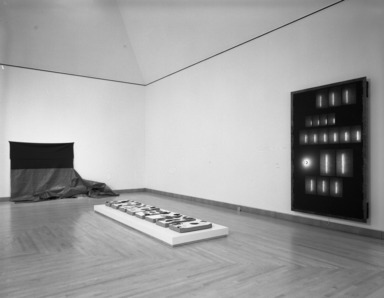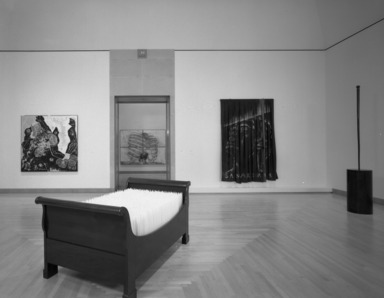

Contemporary Art (installation)., January 01, 1995 through 1996 (date unknown) (Image: PHO_E1995i041.jpg Brooklyn Museum. Justin van Soest,er photograph, 1995)
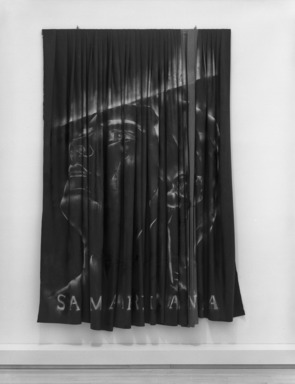
Contemporary Art (installation)., January 01, 1995 through 1996 (date unknown) (Image: PHO_E1995i042.jpg Brooklyn Museum. Justin van Soest,er photograph, 1995)
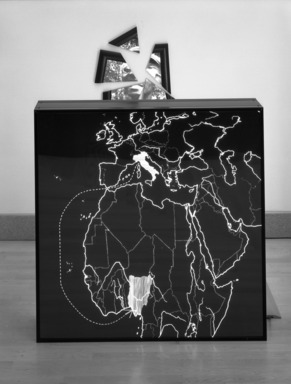
Contemporary Art (installation)., January 01, 1995 through 1996 (date unknown) (Image: PHO_E1995i043.jpg Brooklyn Museum. Justin van Soest,er photograph, 1995)
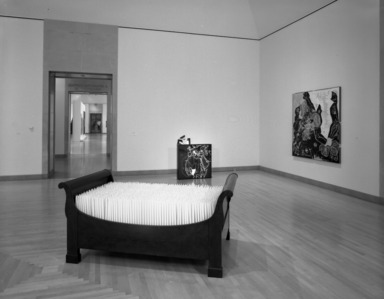
Contemporary Art (installation)., January 01, 1995 through 1996 (date unknown) (Image: PHO_E1995i044.jpg Brooklyn Museum. Justin van Soest,er photograph, 1995)

Contemporary Art (installation)., January 01, 1995 through 1996 (date unknown) (Image: PHO_E1995i045.jpg Brooklyn Museum. Justin van Soest,er photograph, 1995)
Contemporary Art (installation).
-
August 1, 1995
The galleries of postwar and contemporary art at The Brooklyn Museum will be enriched by the addition of more than one dozen works by Polly Apfelbaum, AIfredo Jaar, Donald Lipski, Dennis Oppenheim, and James Turrell, among others, to be placed on long-term view beginning August 25, 1995. Drawn from the Museum’s permanent collection by Charlotta Kotik, Chairman, Department of Painting and Sculpture, and Curator, Contemporary Art, the works complete the galleries’ chronological display of objects dating from 1945 through 1994.
The Museum’s initial installation, featuring works by such artists as Francis Bacon, Robert Colescott, Grace Hartigan, and Louise Nevelson, highlights the diverse materials and stylistic approaches employed by postwar artists as they reexamined the conventions of representation and explored the expressive potential of line, form, and color.
Newly installed works by Jaar, Oppenheim, and Turrell incorporating the schematic landscapes of maps demonstrate landscape’s enduring tradition. Jaar records the devastation of a Nigerian Village by imported toxic waste in Geography = War (1990). Turrell’s Study for Craters (1987) and Oppenheim’s Bound[a]ry Split (1968) each document a work carved by the artist into the landscape.
The figure is conspicuously absent from both Untitled C-23 (1991), a sculpture constructed from a bed and candles by Lipski, and Jon Kessler’s abstract portrait Peter Kubelka (1988). The pulsing electric lights and translucent fabric comprising Kessler’s work evoke both the filmmaker’s profession and the beating of his heart. Kessler’s preoccupation with light and balance reveals his concern for the formal qualities of art, a concern shared by many other contemporary artists included in the installation.
Apfelbaum subverts the Minimalist tradition in The Dwarves w/o Snow White (1992) by topping a series of spare, geometric boxes with folded sheets of white crushed velvet stained with large, densely colored drops. Both Heather Hutchison’s Eclipse (1990) and Joe Zucker’s Boxing Painting Round #2 (1981) reveal the rich textures of the artists’ chosen materials. The fabrics used by James Hyde to construct Float (1993), and by lzhar Patkin to make his work Samaritana (1980-81), are frankly industrial, suggesting socio-political content. These artists, however, have exploited the materials’ color and drape, indicating a renewed appreciation for formal beauty.
Brooklyn Museum Archives. Records of the Department of Public Information. Press releases, 1995 - 2003. 07-12/1995, 122-3.
View Original
